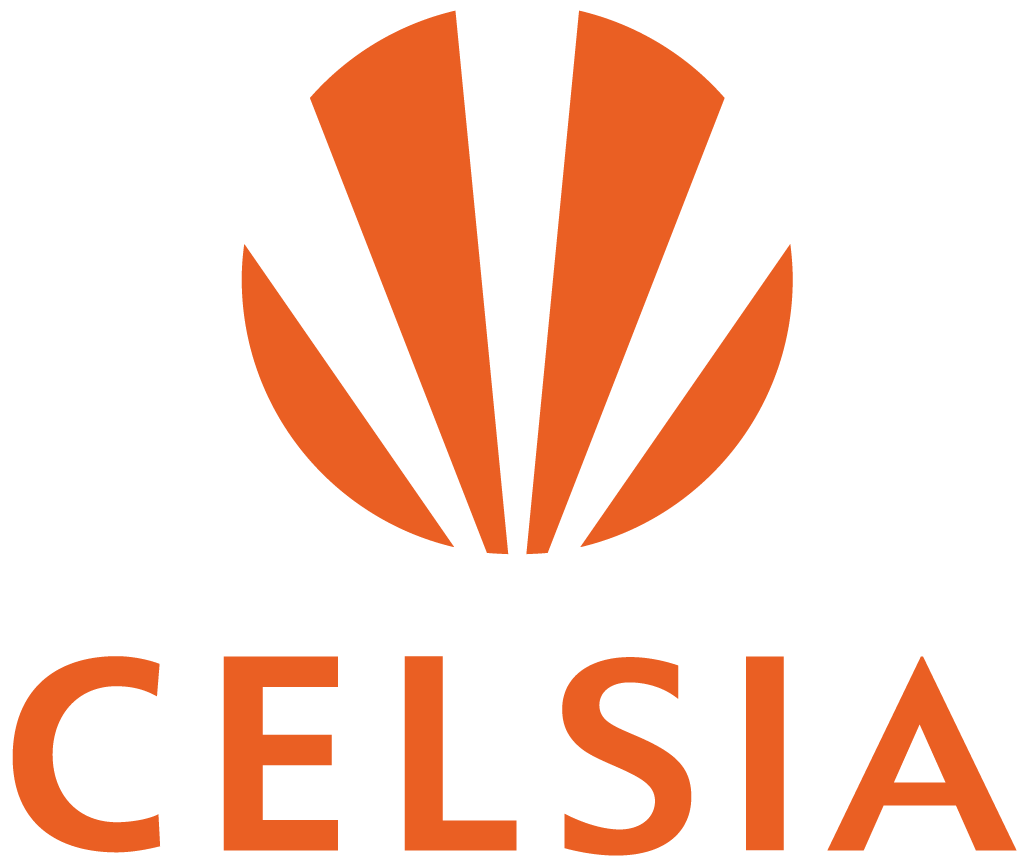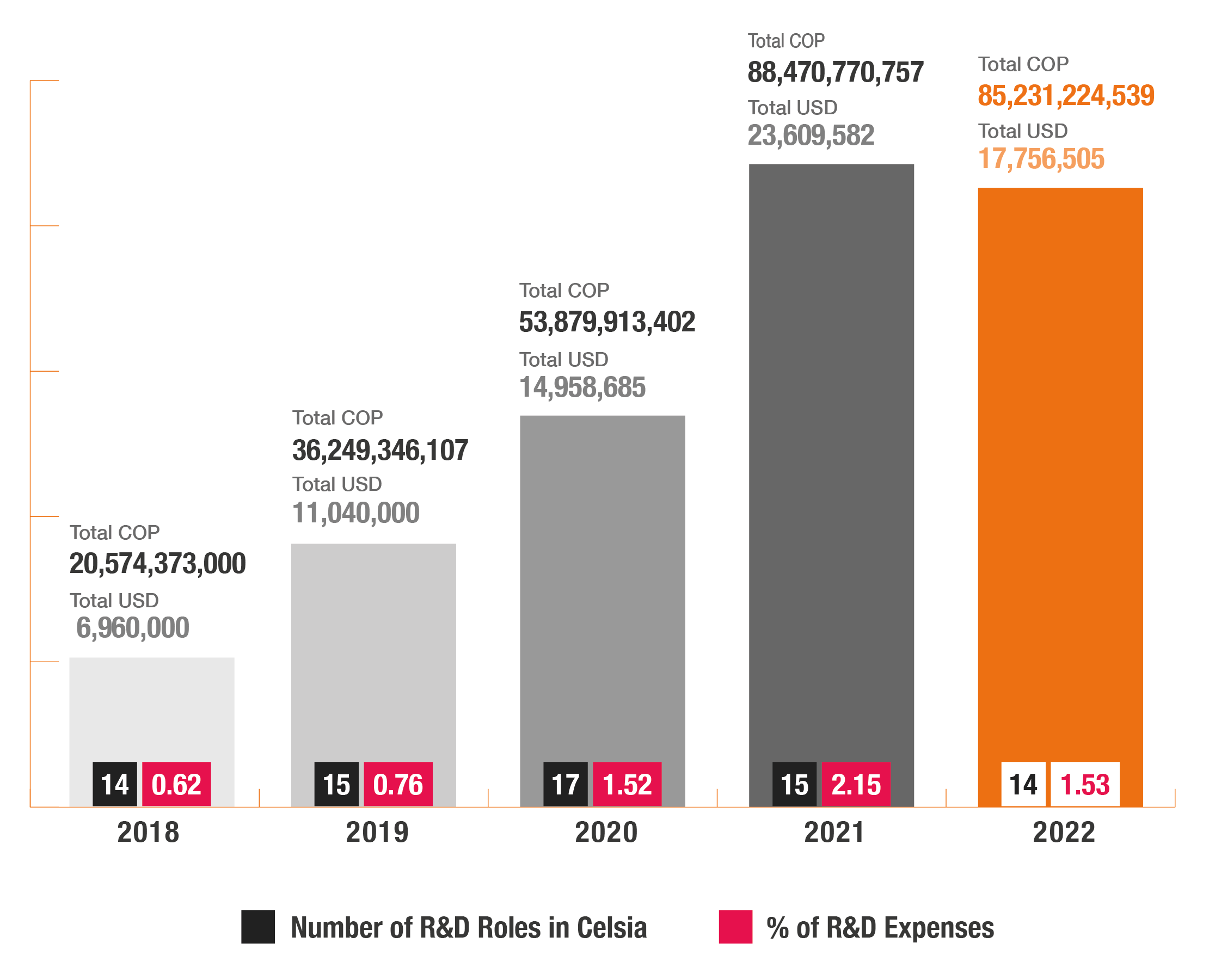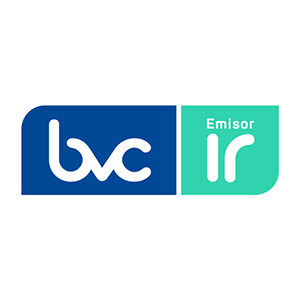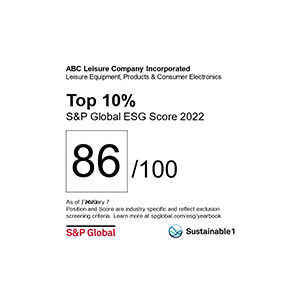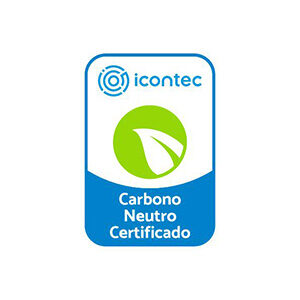Innovation is in Celsia’s DNA and culture; it is a transversal axis of the Organization and is implicit in the Pillars that state: “We dare to be different” and “We are agile and reliable.”
GRI (3-3) Innovation allows us to generate new business models and be flexible when it comes to finding a solution that suits our clients, allowing us to better manage our assets to contribute substantially to the diversification of the country’s energy matrix and present innovative solutions that have a positive impact on all Stakeholders.
Our Management
Horizon 1
Horizon 2
Horizon 3
Horizon 4
GRI (3–3) (2-23) (2-24) (2-25) (2-29) Our Strategic Business Planning is defined by horizons in which innovation is present in each of them, but with greater emphasis on the medium (H3) and long term (H4). The Innovation Team guides the incubation of business ideas or the use of technologies up to the Commercial Pilot Stage, so that there is a progressive integration of key areas to refine and scale the product (H2) and, finally consolidate it as a business in commercial operation (H1).
In 2022, we structured the Innovation-Support Engineering Alliance for the technical-economic referencing of H2 production and use technologies. We also achieved the technical conceptualization and different mobility-business schemes with buses. These sketches were extrapolated for small-scale mobility projects in other locations.
Innovation is in Celsia’s DNA and culture. Through the “We dare to be different” Pillar, we express our intention to set ourselves challenges and development paths to break paradigms and seek new ways of doing things in all the Organization’s teams.
Principal Hotspots of Innovation
- Energy Storage: We validate second-life storage prototypes from electric vehicles in small-scale applications; we also work on business cases for opportunities that promote non-conventional renewable energy sources (FNCER, in Spanish) on a large scale.
- Electric Mobility: Through Muverang, electric-mobility solutions are developed and offered. We are working on consolidating the low-power and fast-charging public-charging infrastructure.
- Hydrogen: We analyze the energy potential by evaluating pilot projects and identifying the role that the Company could play in the medium and long term.
- We are looking for new uses and supply models for hydrogen for industry, mobility and energy.
- Energy Efficiency: To provide solutions for lighting, compressed-air and temperature-optimization projects.
- Internet: The automation of processes in the Internet business to improve management and control over assets.
- Microgrids: We developed a Technical Study Guide for microgrids in conjunction with the Electric Power Research Institute (EPRI).
- EnerBit: An initiative that revolutionizes the way our clients relate to their basic services, starting with energy, seeking to make them live and work better.
- Digital Network: To design, develop and implement the digital transformation of the Distribution Network, with use cases in Valle del Cauca and Tolima, through the development of the necessary network capabilities, the design of data-analytics processes and an artificial-intelligence platform.
- Thermal Districts: To structure, build, operate and maintain thermal-district projects.
- Hydraulic Generation Advanced Diagnostic Center: To optimize the operation of hydraulic-generation systems and processes, through the design and implementation of monitoring systems for its main elements and their remote control, which allow the characterization and modeling of the conditions of the hydroelectric -generation system and its components, guaranteeing its reliability and availability.
- Cyber-Asset and Cyber-Intelligence Management: To mitigate the risk of cyberattacks and improve the context on the risk exposure of assets.
Principal Results in 2022
GRI (3-3) We highlight the most-relevant aspects of our Management:
Storage:
We developed and deployed two small-scale storage prototypes with second-life storage for electric vehicles, as well as capabilities to participate in industry associations and help define a roadmap for energy storage.
Microgrids:
We obtained two recognitions focused on the case study of microgrids and we began the implementation of the testing protocols for the Yumbo microgrid.
Exploration:
We achieved the detailed exploration of the technology of phasor-measurement units in distribution systems for local and global scopes.
EnerBit:
With a total of 1,157 clients served, EnerBit is the fifth retailer in the country by number of borders reporting to XM.
Electric Mobility:
We invested COP 2.000 Billion in the installation of new equipment with better technology than that previously implemented; we also offered cloud services that allow charging-station management and control.
Muverang:
We managed to grow three times in terms of billing compared to 2021, closing the year with a billing of COP 4.500 Billion.
Thermal Districts:
We connected the first 105 residential units to the Thermal District.
Digital Network:
We achieved 87% progress in the project with a budget execution to date of 99.52%.
Solar Photovoltaic:
We defined a methodology with witness investors not affected by the control strategy to generate the energy charge.
Geolytics:
We achieved an average sales effectiveness of 47% to 62%.
Automatic Quotes:
We reduced activity times by 15 minutes, avoiding the traffic of three days.
Analytics:
We designed and implemented platforms and services for handling large volumes of data, automation and advanced analytics.
Internet:
We developed Phases 1, 2 and 3 of the project registered in the Colombian Ministry of Science, Technology and Innovation (MinCiencias).
ReverdeC:
We reached and surpassed the goal of 10 million trees planted.
Hydrogen:
We completed the pre-feasibility of a Green-Hydrogen Project.
Energy Efficiency:
We reduced CO2 emissions by 80% and saved 40% in energy.
Digitization:
We implemented 782 measurement points and completed 13 projects.
Hydraulic Generation Advanced Diagnostic Center:
From our Advanced Vision Operations Center (NOVA, in Spanish) we implement the remote operation of the small hydroelectric plants (SHPs) in Valle del Cauca.
Cyber-Assets and Cyber-Intelligence Management:
We achieved the protection of 100% of the substations and critical plants, as well as six generation plants, seven critical substations and 30 non-critical substations.
Interaction:
The permanent interaction with the implementations of pilot projects has allowed us to understand the limitations of the technologies and the adjustments that are required to adapt them to local conditions.
Working together with universities has generated value in two ways:
For us, having the vision and rigor in research that academia has and, for them, having experience in the industry and human talent that characterizes us.
We highlight the investment in innovation that we have made in recent years:
The 3.7% decrease in R&D spending did not represent a significant change in the total area item; however, there were changes in the projects, as some ended in 2021 and others began in 2022, thus giving a balance.
MinCiencias Projects:
The Digital Network
had less investment (around 50% less: COP 14,000 million) during 2022, due to the completion of various scheduled activities.
The Internet
showing a high investment growth compared to 2021.
Center for Advanced Diagnostic in Generation
The Energy Efficiency Project
which had a significant increase in new business
Investment in AMI infrastructure
which had no impact on R&D.
Our work on Microgrid Viability Analysis earned us the 2022 Power Distribution Units (PDU) Technology Transfer Award, which recognizes leaders and innovators who have applied Electric Power Research Institute (EPRI) research to produce meaningful results.
Recognized the Research, Technological Development and Innovation Unit of Celsia Colombia S.A.E.S.P., from October 27, 2021 to October 27, 2024.
As the company that is most related to entrepreneurs, in the Open Innovation 2022 ranking, from the Portafolio newspaper.
Research Category for research and development in the electricity sector.
in the Energy Efficiency Category with the Serena del Mar Thermal-District Project.
GRI (3-3) Short-, Medium- and Long-Term Objectives:
Short Term(0 to 2 years)
- Scale the integration of storage solutions at the level of self-generation end customers.
- Define the technical configurations and the partial portfolio of services for microgrids.
- Develop and quantify business cases for local flexibility (flex resources).
- Participate in the technical and economic structuring of transmission projects in Colombia.
- Evaluate the technology of phasor-measurement units in distribution systems in controlled pilot projects.
- EnerBit: Conquer the largest number of energy clients in the regulated market. By 2023 we expect to close with more than 10,000.
- Launch the new Electric-Mobility App and put the payment process for the recharging service at stations into operation.
- Complete the construction of the Gran Manzana Thermal District and connect Social-Interest Housing (VIS, in Spanish) units to the system.
- Solar Photovoltaic (SFV, in Spanish): Comply with the Generation, Availability and Performance Standards of the defined systems.
- Develop ways to monetize data and learn to quantitatively measure all the impacts of an analytics.
- Automate, systematize and standardize Internet-Business processes.
- Implement a Carbon-Credit Certification Methodology for properties that are part of the ReverdeC program.
- Evaluate and test new technologies; consolidate the first hydrogen businesses.
- Stabilize the operation of ongoing Energy-Efficiency Projects.
- Cover 60 substations in Tolima with Cyber-Asset Management and cyber intelligence.
Medium Term(3 to 5 years)
- Scale the integration of energy-storage solutions from end clients to other geographies.
- Develop the implementation of flexibility services in our networks.
- Develop business models that allow microgrids to create value for the Company.
- Scale the Phasor Measurement-Unit Technology in distribution systems in Distribution Networks.
- Grow Celsia’s digital marketing client base by at least 50%.
- Consolidate the best charging experience in Colombia for electric mobility, with a simple process, few steps and a first-class level of service.
- Define the electrification and linkage of renewables as primary energy sources of the thermal districts.
- Structure new business models associated with photovoltaic solutions, which make it possible to make isolated microgrid projects viable.
- establish automatic controls that guarantee the quality of the sale when using the Geolytics initiative.
- achieve fully self-sustaining Analytics-Platform operation.
- expand the range of action of the ReverdeC Program to other areas and Departments of the country.
- have the first production plant for hydrogen derivatives in Celsia.
- Scale solutions to develop larger-scale Energy-Efficiency Projects in the tertiary and industrial sectors.
- implement the Hydraulic Advanced-Generation Diagnostic Center (AGDC) in the remote operation of Río Piedras, Hidromontañitas, San Andrés de Cuerquia and Cucuana.
- Carry out evolutionary maintenance of the Cyber-Asset and Cyber-Intelligence Management Tool.
Long Term(6 or more years)
- Diversify storage technologies as a mature, well-established business.
- Extend flexibility services in Distribution Networks.
- Begin the materialization of high-voltage direct-current technology for the country.
- Establish microgrids as a service integrated into the Company’s operation.
- Venture into other products adjacent to digital-energy trading.
- Develop an investment platform for charging infrastructure with greater emphasis on fast-charging projects for buses and trucks in the countries where Celsia is present.
- Use alternative energy sources, such as ammonia, hydrogen, wind, solar photovoltaic and thermal, and exchange of thermal energy in bodies of water.
- Develop digital capabilities in use cases and transform the planning, operation and maintenance process in the Digital-Network Project. Also, design a Distribution-System operator and create, build and incorporate artificial-intelligence models in the Distribution Network.
- Convert Celsia’s Analytics Platform into the main lever of the Company’s digital transformation.
- Add the distribution of digital services to Celsia’s portfolio.
- Consolidate the offer of products and services for the hydrogen economy.
- Test and implement new technologies from non-conventional renewable-energy sources for heating and storage of thermal energy.
- Implement in Salvajina and Calima the capabilities of the Center for Advanced Diagnostics in Hydraulic Generation (AGDC).
Microgrids: A group of loads and distributed-energy resources with a clearly defined electrical border, which has the capacity to be self-sufficient and operate in isolation or in parallel with the electrical system to meet local demand.
AMI: Advanced Metering Infrastructure (Smart Meters).
Muverang: An electric-mobility venture developed jointly with SURA and Bancolombia, which seeks to contribute to the development of sustainable cities.
MinCiencias: The Ministry of Science, Technology and Innovation of Colombia.
Internet of Things (IoT): The digital interconnection of everyday objects with the Internet, thus becoming intelligent objects, which send and receive data to improve the functionality both individually and integrated of the connected elements.
Geolytics: A tool to optimize the sale of the retail business.
